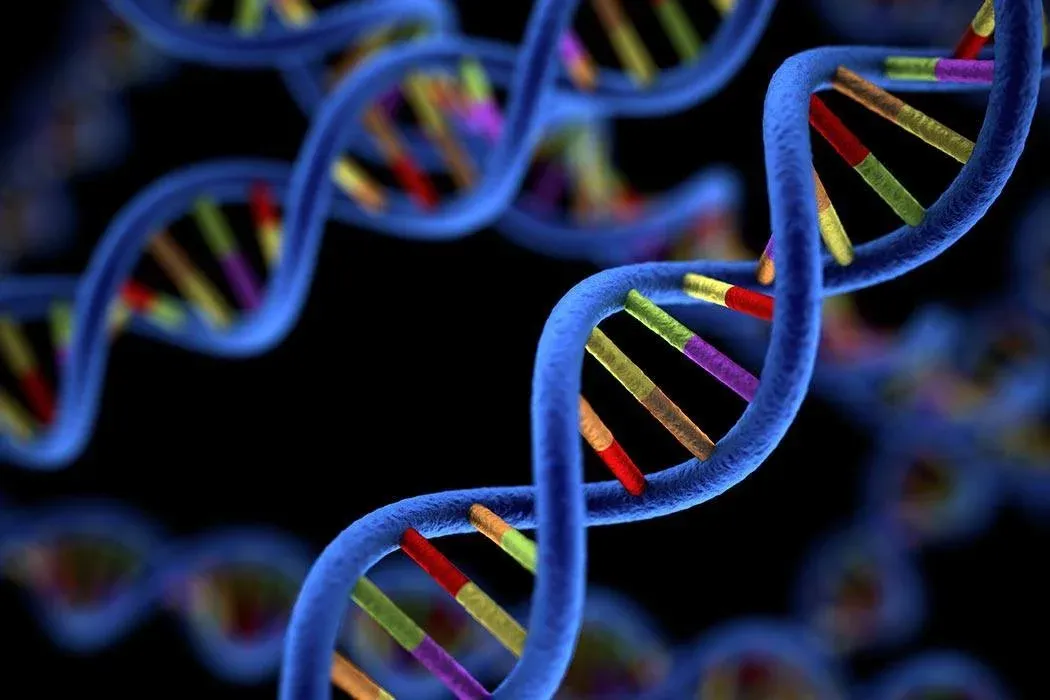
Okay, I admit, we IB physicists might have a tendency to mock our IB biologists for lacking maths and just simply memorising everything, but that couldn't be further from the truth when examining the topic of today's post, the DNA double helix. This is an intricate geometric shape with many fascinating mathematical properties that we will now explore. To do this, we will dive into a fascinating field of study called differential geometry which will allow us to see how one set of formulae can describe the intrinsic properties of the double helix.
Before we dive right into the formulae, it's important that we understand a few terms first:

In this diagram, the tangent, normal and binormal vectors at a point on a space curve are labelled. (A space curve is a curve that may pass through three-dimensional space, in contrast to a plane curve which must lie in a single, two-dimensional plane). The osculating plane, i.e. the plane that "kisses" the curve at the point, is also shown.
Note that all three quantities are unit vectors, which means that they all have a magnitude of 1. They are also all perpendicular to each other.
We now want to define two other quantities
I won't bother explaining how these formulae are derived, as the derivation is long; instead, let's just appreciate the beauty of its simplicity: $$ \begin{matrix} \frac {d\mathbf {T} }{ds} &= & &\kappa \mathbf {N} & \\ \frac {d\mathbf {N} }{ds} &= &-\kappa \mathbf {T} & &+\tau \mathbf {B} \\ \frac {d\mathbf {B} }{ds} &= &&-\tau \mathbf {N} & \end{matrix} $$
Alternatively, this can be expressed even more concisely using the following matrix:
$$ {\begin{bmatrix}\mathbf {T'} \\\mathbf {N'} \\\mathbf {B'} \end{bmatrix}}={\begin{bmatrix}0&\kappa &0\\-\kappa &0&\tau \\0&-\tau &0\end{bmatrix}}{\begin{bmatrix}\mathbf {T} \\\mathbf {N} \\\mathbf {B} \end{bmatrix}} $$Again, although we will not formally derive it here (as the proof uses the Gram-Schmidt process and is rather cumbersome), it can be shown that $\kappa = \frac{\|\mathbf{r}'\times\mathbf{r}''\|}{\|\mathbf{r}'\|^3}$ and $\tau = \frac{[\mathbf{r}',\mathbf{r}'',\mathbf{r}''']}{\|\mathbf{r}'\times\mathbf{r}''\|^2}$ where $\mathbf{r(t)}$ is the formula for a curve and $[\mathbf{r}',\mathbf{r}'',\mathbf{r}''']$ represents the scalar triple product. We can use this fact to analyse the curvature and torsion of various curves.
The helix is a spiral staircase shape like shown below:

It can be defined by the parametric equations
$$
\begin{cases}
x(t)=a\cos t,
\\ y(t)= a\sin t,
\\ z(t)=bt.
\end{cases}
$$
To quote the almighty Wikipedia article, helices are important in biology, as the DNA molecule is formed as two intertwined helices, and many proteins have helical substructures, known as alpha helices.
So let's explore them in more detail.
We can take the parametric equation above and rewrite it in terms of a vector $\mathbf{r}$. We can then differentiate it three times to find the expressions $\mathbf{r'}$, $\mathbf{r''}$ and $\mathbf{r'''}:$ $$\begin{aligned} \\ \mathbf{r} &= a\cos{t} \ \mathbf{i}+a\sin{t}\ \mathbf{j} +bt\ \mathbf{i} \\ \mathbf{r'} &= -a\sin{t} \ \mathbf{i}+a\cos{t}\ \mathbf{j}+b\ \mathbf{i} \\ \mathbf{r''} &= -a\cos{t} \ \mathbf{i}-a\sin{t}\ \mathbf{j} \\ \mathbf{r'''} &= a\sin{t} \ \mathbf{i}-a\cos{t}\ \mathbf{j} \end{aligned} $$ Taking the cross product of $\mathbf{r}$ and $\mathbf{r'}$ (i.e. the determinant of the 3x3 matrix), $$ \begin{aligned} \mathbf{r} \times \mathbf{r'} &= \begin{vmatrix} \mathbf{i} & \mathbf{j} & \mathbf{k} \\ -a\sin{t} & a\cos{t} & b \\ -a\cos{t} & -a\sin{t} & 0 \end{vmatrix} \\ \\ &=\mathbf{i}ab\sin{t}-\mathbf{j}ab\cos{t}+a^2(\sin^2{t}+\cos^2{t})\mathbf{k} \\ &= \mathbf{i}ab\sin{t}-\mathbf{j}ab\cos{t}+a^2\mathbf{k} \end{aligned} $$ Now, we can take the magnitude of this cross product: $$ \begin{aligned} \\ |\mathbf{r'} \times \mathbf{r''}|&=\sqrt{(ab\sin{t})^2+(-ab\cos{t})^2+(a^2)^2} \\ &= \sqrt{a^2b^2(\sin^2{t}+\cos^2{t})+a^4} \\ &= a\sqrt{a^2+b^2} \end{aligned} $$ To calculate the scalar triple product, we will then perform the dot product with $\mathbf{r'''}$: $$ \begin{aligned} \\ (\mathbf{r'} \times \mathbf{r''})\cdot \mathbf{r'''} &= (\mathbf{i}ab\sin{t}-\mathbf{j}ab\cos{t}+a^2\mathbf{k}) \cdot (a\sin{t} \ \mathbf{i}-a\cos{t}\ \mathbf{j}) \\ &=a^2b\sin^2{t}+a^2b\cos^2{t}+0 \\ &=a^2b(\sin^2{t}+\cos^2{t}) \\ &=a^2b \end{aligned} $$ Finally, we want to quickly compute $|r'|$ which is very easy to do: $$|\mathbf{r'}|=\sqrt{a^2\sin^2{t}+a^2\cos^2{t}+b^2}=\sqrt{a^2+b^2}$$ Now we have all the quantities we need to calculate the torsion: $$ \begin{aligned} \tau &= \frac{[\mathbf{r}',\mathbf{r}'',\mathbf{r}''']}{\|\mathbf{r}'\times\mathbf{r}''\|^2} \\ &=\frac{a^2b}{(a\sqrt{a^2+b^2})^2} \\ &= \frac{b}{a^2+b^2} \end{aligned} $$ and curvature: $$ \begin{aligned} \kappa &= \frac{\|\mathbf{r}'\times\mathbf{r}''\|}{\|\mathbf{r}'\|^3} \\ &=\frac{a\sqrt{a^2+b^2}}{(\sqrt{a^2+b^2})^3} \\ &=\frac{a}{a^2+b^2} \end{aligned} $$ From these formulae, we can see that if $a,b>0$ (which is a valid simplification since the negative values are simply symmetric), then as $b$ increases, curvature decreases (due to the factor of $b^2$ in the denominator) but torsion increases (due to the factor of $b$ in the numerator). You can explore this complementary behaviour in the graph below:
Moreover, from the formulae above, we can conclude that the torsion and curvature of any point on a helix is constant (the expressions are only in terms of constants $a$ and $b$, and is not dependent on the variable $t$).
Knowing that a helix has constant torsion and curvature, I wondered whether are any biological implications for the DNA double helix. As this was a question that nobody else seemed to ask (at least I couldn't find it on the internet), I asked this question on the biology stack exchange. And indeed there was.
As I do not know much about biology, I would like to quote the answer from a user.
The regularity of the helix (constant curvature and torque) maximizes base stacking, which involves the π–π interactions of the purine and pyrimidine rings. This is important for maintaining the structure of the double-helix and hence facilitating its function.
For a more detailed explanation, go read his full answer here.
This was a fascinating dive into multivariable calculus and differential geometry, tying together a seemingly unrelated concept of tangents, normals and binormals with a fascinating application to the DNA double helix.